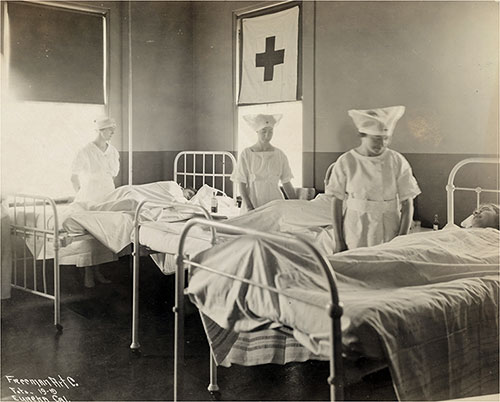The Influenza Mystery Deepens - 1919

Volunteer Nurses at the Red Cross Hospital in Eureka, California During the Influenza Epidemic, circa 1918-1919. Photograph Courtesy of the American Red Cross, Humbordt County Capter, Eureka, CA. National Archives and Records Administration RG 165-WW-269B-18. NARA ID # 45499325. GGA Image ID # 150c51661d
Some time ago in commenting on the spread of epidemic influenza, we spoke of the disease as "a disease of mystery." That this is even more true today is indicated by experiments just made public by the United States Public Health Service.
It may be recalled that medical scientists are by no means agreed as to the nature of influenza. The influenza bacillus discovered by Pfeifier in 1892 has, it is true, been found associated in a large proportion of the cases during the present world-wide epidemic, but the best opinion looks upon this bacterium as more probably a secondary invader, and holds that the true causative micro-organism has not yet been isolated.
Some months ago, Nicolle, a well-known French bacteriologist, reported the results of a series of experiments which indicated that the virus of influenza was "ultra-microscopic," and able to pass through filters of unglazed porcelain.
This announcement appeared the more credible since the investigations by Foster, an American army surgeon, had already shown that common colds are caused by a filterable virus.
Quite unexpectedly, however, Rosenau of Harvard, made public the results of experiments which he believed indicated that the virus of influenza was not filterable.
He introduced into the nose and throat of a number of volunteers filtered secretions from active cases of influenza and failed to reproduce the disease.
Careful examination of the protocols of Rosenau's experiments showed, however, that he had failed to test the infectivity of the unfiltered secretion.
It was to remedy these defects in the investigations that a second series of experiments was made, this time in cooperation with the Hygienic laboratory of the United States Public Health Service.
In this investigation, which was carried on both in Boston and San Francisco, over one hundred men of the naval training station volunteered to submit themselves to experimental inoculations.
By means of sprays and swabs filtered and unfiltered secretions from active cases of influenza were transferred to the nose and throat of the volunteers.
In addition to these pure cultures of Pfeiffer bacilli were similarly introduced; for, after all, it was still important to know whether this could produce typical influenza.
Finally, in order to reproduce natural conditions as much as possible, a group of volunteers, brought into a ward in which were active cases of influenza, leaned over each of ten bed patients, conversed a few minutes and allowed the patients to cough into their faces.
And the result? —in not a single instance was influenza thus produced in any of the volunteers!
It is, of course, possible, that in influenza the virus is present in the nasal secretions for only a limited period.
This is the case, for example, in measles. In yellow fever, too, we know that the virus exists in the blood for only a few days, so that search made before and after that period invariably yields negative results.
By analogy, there is still every reason to believe that influenza is most commonly spread by droplet infection, i. e., by close contact with influenza patients who cough, sneeze and spit.
This, too, is the view of Surgeon General Blue, who warns against a misinterpretation of the experiments just cited. More than ever, therefore, influenza is to be regarded as the disease of mystery.
"The Influenza Mystery Deepens," in The Scientific American: The Weekly Journal of Practical Information, New York: Scientific American Publishing Company, Vol. CXX, No. 5, 1 February 1919, p. 92.
